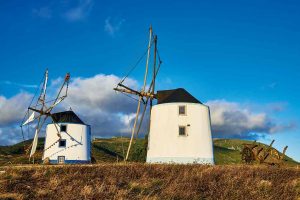With its pastel-coloured buildings topped with terracotta tiles, yellow-and-white trams climbing the city’s steep streets and its famous pastéis de nata custard tarts, Lisbon draws tourists from across Europe and beyond. Yet visitors stepping outside the Portuguese capital will be rewarded by discovering a winemaking region that brings together the best of the country’s high-quality indigenous varieties and carefully selected international partners.
Part of that successful marriage of domestic and foreign grapes is possible because of the broad range of soils and climatic conditions found in the Lisboa region. Stretching for 150km and reaching 40km at its widest point, the area extends from the beach at Leiria, north of the capital, down to the beach at Carcavelos, to the capital’s west.
The Atlantic’s strong influence fades as it reaches the chain of mountains that run along a north-south axis, with the coast’s sandier soils giving way to stonier, hilly sites inland. The area’s clay soils are punctuated with patches of almost-black clay, hinting at the ancient volcanic chimneys that lie below.
This patchwork of soils has led to nine areas within the region being awarded their own designations – Denominação de Origem Protegida (DOP). Many wines use the wider regional Indicação Geográfica Protegida (IGP) designation, which gives more room to experiment with grape varieties and winemaking techniques.

Vines are grown by around 2,000 growers, who harvest grapes spread across 10,000ha. The average area tended by each grower is 5ha, which is higher than the national average.
Local varieties such as Aragonez, Arinto and Touriga Nacional (and the emblematic, but relatively rare, Vital, Ramisco and Tinta Miúda) rub shoulders with Chardonnay and Syrah.
Sales of the region’s wines have doubled during the past five years to 65 million bottles a year, and soared by 17% in 2020 alone. Drinkers in the US, the UK, Brazil, Canada, Australia and Poland have fallen in love with the region’s wines; around 80% of production is exported to about 100 markets.
Half of the region’s vineyards have been restructured over the past 15 years as Lisboa’s growers and winemakers continue to embrace new ideas and strategies. That quest to continually improve quality even further is reflected in the taste of the famous Lisboa blends.
Lisboa Wines to Try

Porta 6 Reserva 2018
£11.99 Majestic
The reserve version of the fruity Porta 6 Red adds woodsmoke, cedar and milk chocolate to the intense cassis aromas. A blend of 40% Syrah, 20% Alicante Bouschet, 20% Cabernet Sauvignon and 20% Touriga Nacional produces ripe, well-integrated tannins, with balance coming from sweet vanilla, red cherry, and raspberry and blackberry jam notes.

Stones & Bones 2019
£10.49 Laithwaites
Ancient boulders and dinosaur fossils inspired the name for this blend of Syrah, Touriga Nacional, Tinta Roriz and Alicante Bouschet. Winemaker Diogo Sepúlveda uses the skills he learned in Pomerol, Napa and Barossa to coax bright acidity, well-integrated ripe tannins, spun sugar, spicy clove, red cherry, and blackcurrant from his old vines.

CH By Chocapalha 2018
£34.25 Corney & Barrow
Described by winemaker Sandra Tavares da Silva as a tribute to her family’s Swiss heritage, this Touriga Nacional has aromas of cream, violets, roast meat and black cherry, joined by sweet vanilla and blackberry jam on the palate. The oak lets the fruit shine through, and there’s enough of both to balance the assertive tannins. The 2018 vintage will go on sale early in 2022.

Quinta do Monte d’Oiro Reserva 2016
£39.50 Amathus Drinks
Italian-style aromas of bright red cherry, redcurrant, spun sugar, and cedar. Ripe tannins are balanced by sweet vanilla, raspberry jam and red cherry, creating a warming winter red that’s rich with concentrated fruit. A 4% dash of Viognier is co-fermented with the Syrah.

Consensus, Pinot Noir & Touriga Nacional 2016
£13.99 Banstead Vintners
A single-estate blend of 50/50 Pinot Noir and Touriga Nacional produces aromas of bright red cherry, raspberry, woodsmoke and roast meat. On the palate, the bright acidity is balanced by lighter strawberry and redcurrant, leading into sweeter spun sugar and richer blackcurrant on the finish.

Casa das Gaeiras, Óbidos 2019
£12 Amathus Drinks
Óbidos, with its mild climate and morning hill mists, is known for its lighter style of wines. Casa das Gaeiras is light on its feet, with bright acidity and a mix of blackcurrant, blueberry, raspberry and vanilla from a blend of Syrah, Touriga Nacional and Tinta Roriz.
 Companhia Agrícola do Sanguinhal, Quinta de S. Francisco, Óbidos 2018
Companhia Agrícola do Sanguinhal, Quinta de S. Francisco, Óbidos 2018
£13.50 The Real Wine Company
Mellow black fruit on the nose, exploding into a bright array of red fruit on the palate,
stretching from raspberry and strawberry through to redcurrant, all wrapped in spun sugar. It’s fresh and bright, but with enough tannin to provide backbone.

Villa Oeiras Vinho Generoso 7 years
£24.50-£25 (for 375ml) Vinoteca, Bar Douro
Villa Oeiras fortifies its blend of Arinto, Galego Dourado, and Ratinho with 77% brandy from the Lourinhã region to create a golden wine with 18.5% alcohol by volume. Caramel and nutty notes on the nose are joined by sweet honey on the palate. Spending an average of seven years in Portuguese and French oak means its woody tannins lend themselves to pairing with cheeses and pâtés.




 Companhia Agrícola do Sanguinhal, Quinta de S. Francisco, Óbidos 2018
Companhia Agrícola do Sanguinhal, Quinta de S. Francisco, Óbidos 2018



